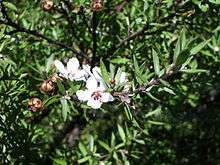Leptospermum scoparium
| Leptospermum scoparium | |
|---|---|
 | |
| Leptospermum scoparium foliage and flowers | |
| Scientific classification | |
| Kingdom: | Plantae |
| (unranked): | Angiosperms |
| (unranked): | Eudicots |
| (unranked): | Rosids |
| Order: | Myrtales |
| Family: | Myrtaceae |
| Genus: | Leptospermum |
| Species: | L. scoparium |
| Binomial name | |
| Leptospermum scoparium J.R.Forst. & G.Forst. | |

Leptospermum scoparium, commonly called mānuka, manuka myrtle,[1] New Zealand teatree,[1] broom tea-tree,[2] or just tea tree, is a species of flowering plant in the myrtle family Myrtaceae, native to Australia and New Zealand.[1][3][4]
Description
It is a prolific scrub-type tree and is often one of the first species to regenerate on cleared land. It is typically a shrub growing to 2–5 m (7–16 ft) tall, but can grow into a moderately sized tree, up to 15 m (49 ft) or so in height. It is evergreen, with dense branching and small leaves 7–20 mm long and 2–6 mm broad, with a short spine tip. The flowers are white, occasionally pink, 8–15 mm (rarely up to 25 mm) in diameter, with five petals. This species is often confused with the closely related species kānuka – the easiest way to tell the difference between the two species in the field is to feel their foliage – mānuka leaves are prickly, while kānuka leaves are soft.[5] The wood is tough and hard.
History and habitat
Evidence suggests that L. scoparium originated in Australia before the onset of the Miocene aridity, and dispersed relatively recently from eastern Australia to New Zealand.[6] It has been postulated that on arrival in New Zealand, L. scoparium became established in limited edaphically suitable areas until the arrival of the Polynesian people, whose fire and forest-clearing brought about the low-nutrient-status soils for which it was preadapted in its homeland.[3] It is now found throughout New Zealand, but is particularly common on the drier east coasts of the North and South Islands, and in Australia in Tasmania, Victoria and New South Wales.
Ecology
Pests and diseases
The adult manuka beetle and its larvae feed on L. scoparium.[7]
Names
Mānuka (from Māori) is the common name used. "Jelly bush" and "tea tree" are also used in Australia and to a lesser extent in New Zealand. This name arose because Captain Cook used the leaves to make a 'tea' drink.[8]
Cultivation
Numerous cultivars have been developed for garden use, of which the following have gained the Royal Horticultural Society's Award of Garden Merit:-
Many more cultivars are available in New Zealand but often the plant performs better in cultivation overseas. This is because in its homeland it is subject to attack by scale insects that secrete a honeydew on which grows a sooty mold that eventually debilitates the plant. Because of this, attempts have been made, with limited commercial success, to cross the showy New Zealand cultivars with mold-resistant Australian Leptospermum species.[13]
Uses
The wood was often used for tool handles. Mānuka sawdust imparts a delicious flavour when used for smoking meats and fish. It is cultivated in New Zealand for mānuka honey, produced when honeybees gather the nectar from its flowers, and for the pharmaceutical industry. It is also used for carving and producing essential oils by steam distillation of its leaves. Manuka Essential Oil is modernly used widely as a potent natural anti-fungal and antibacterial agent. Manuka, as it is called by most New Zealanders, was used in pre-European times by the traditional people of New Zealand, the Maori, and still is. A decoction of the leaves was drunk for urinary complaints and as a febrifuge (an agent for reducing fever). The steam from leaves boiled in water was inhaled for head colds. A decoction was prepared from the leaves and bark and the warm liquid was rubbed on stiff muscles and aching joints. The emollient white gum, called pai Manuka, was given to nursing babies and also used to treat scalds and burns. Chewing the bark is said to have a relaxing effect and it enhances sleep.[14]
Parakeets and parasites
Kakariki parakeets (Cyanoramphus) use the leaves and bark of mānuka and kānuka to rid themselves of parasites. Apart from ingesting the material, they also chew it, mix it with preen gland oil and apply it to their feathers.[15]
See also
- Manuka, Australian Capital Territory, which, although it is pronounced differently, was indirectly named after the New Zealand tree.
- Tea plants (Camellia sinensis), as opposed to tea trees (mānuka, Leptospermum scoparium) are also grown commercially in New Zealand.
- New Zealand Plant Conservation Network - Leptospermum scoparium var. scoparium
References
- 1 2 3 "USDA GRIN Taxonomy".
- ↑ "BSBI List 2007" (xls). Botanical Society of Britain and Ireland. Retrieved 2014-10-17.
- 1 2 Derraik, José G. B. (2008). "New Zealand manuka (Leptospermum scoparium; Myrtaceae): a brief account of its natural history and human perceptions" (PDF). New Zealand Garden Journal. 11 (2): 4–8. Retrieved 2 May 2016.
- ↑ Thompson J., (1988) A revision of the genus Leptospermum (Myrtaceae) Telopea 3(3): 301-449
- ↑ J. Dawson, R. Lucas, Nature guide to the New Zealand forest. Godwit, 2000
- ↑ Thompson J., (1988) A revision of the genus Leptospermum (Myrtaceae) Telopea 3(3): 301-449
- ↑ "Shrublands guide" (PDF). Auckland Council. Auckland Council. Retrieved 2 May 2016.
- ↑ J. T. Salmon, The Native Trees of New Zealand, Reed, 1973. ISBN 0-589-01340-8
- ↑ "RHS Plant Selector - Leptospermum scoparium 'Kiwi'". Retrieved 21 May 2013.
- ↑ "RHS Plant Selector - Leptospermum scoparium 'Nichollsii Nanum'". Retrieved 21 May 2013.
- ↑ "RHS Plant Selector - Leptospermum scoparium 'Red Damask'". Retrieved 21 May 2013.
- ↑ "RHS Plant Selector - Leptospermum scoparium 'Silver Sheen'". Retrieved 21 May 2013.
- ↑ "1999 RNZIH Conference Report". Retrieved 5 December 2013.
- ↑ http://www.manukaoil.com/manuka_oil_uses.htm
- ↑ T. Greene, Antiparasitic behaviour in New Zealand parakeets (Cyanoramphus species). Notornis 36 (4) (1989): 322–323. PDF